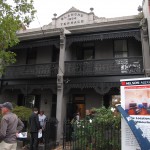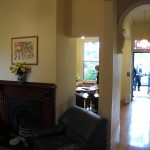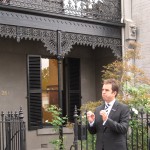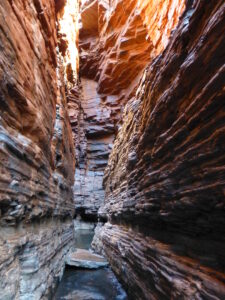
We’ve done a lot of walking around the high-class inner suburbs of Melbourne. Regularly we see oversized posterboards attached to the fences of homes advertising the house for sale. But most don’t invite you to go to set an appointment for viewing; instead, they announce a specific date when the home will be auctioned in a “fair and open manner” to the public.
We were curious, so when we passed a house for sale in the nearby suburb of Carlton, one of the most desirable areas close to the inner city, we decided to go.
About an hour before the scheduled auction time, the house opened for viewing by potential bidders – and curious neighbors. It was a narrow two-story townhouse huddled together with similar ones on a very busy road heading north from the city. The outside certainly showed well. As is typical of Carlton homes dating from the turn of the 20th century, lots of classy wrought iron filigree adorned the second floor balcony and lower verandah. The traditional stone arch on top designated the building as “Blanche Terrace 1901”.
Except for that noisy road, it had a great location. Across the street you could see the Carlton Gardens, with its engaging Melbourne Museum and the neo-classical Royal Exhibition Centre, plus lots of green space to enjoy. More bohemian and somewhat trendy Fitzroy begins just on the other side of the park. A short distance in the other direction stretch blocks of what make this area especially attractive: the chi-chi shops and endless restaurants, 80% of which seem to be Italian (Many Italians moved here after World War II, and you still hear lots of people speaking Italian in the streets.) It’s also a quick tram ride, or 30 minute walk, into the CBD as well.

But they built them small in those days, really small. The interior was just over 4 meters wide (about 13 feet) and a total of perhaps 90 square meters (under a 1000 square feet) even if you include the only stairwell in the middle. The three bedrooms upstairs were described as “generous” in the brochure, but the largest was 18.5 square meters, or about 200 square feet, the smallest about half the size. Though presentable, the interior was quite dowdy, with some decorative trim downstairs, but otherwise very plain in the bedrooms. A small deck toward the rear of the second floor opened on the neat back ends of similar houses already substantially renovated. The only bathroom? Downstairs through a narrow passageway past the workable, but aging kitchen.
In the brief time it took to wander through, we passed a number of people studying the house documents or eating the cookies supplied, while several couples huddled in corners, presumably formulating offers and bidding strategies.
We spoke for a few minutes with the broker running the auction about the difference between Australia and the United States. In the USA, we noted, virtually all properties sold at auction are foreclosed ones. Once a month in Texas, for example, seized properties are set for auction at the County courthouse. Otherwise, the usual process is an elaborate dance between buyers and sellers, an extended bidding process mediated by their broker representatives and costing a whopping 6% in commissions, a real luxury these days.
By contrast, he informed us, auctions in Melbourne – and presumably the rest of Oz – are the method of choice for roughly two of every three sales. Clearly auctions are much more efficient, as they avoid the lengthy process of searching, investigating, bidding, negotiating and closing that characterize non-auction sales. Here, as a result, the typical time for a home on the market is less than a month, essentially the time to prepare the house, get out the adverts and run the auction. The seller’s broker gets only 2% of the sales price, the same as if they did things with no auction, and there is no money for a buyer’s broker. That’s why, if you want to buy a house, you yourself search each real estate company’s listings or peruse a consolidator like realestate.com.au.

As the auction time of 1PM approached, we headed back outside with about 40 to 50 others. “A good crowd,” the auctioneer had said. We expected some spirited action. Then it was time, and the auctioneer – in age-old fashion – started talking up the property, though saying actually very little about the place itself. He spoke loudly so he could be heard over the tumult of traffic. You’re buying the parkland, he admonished (as he gestured across the road), the pleasures of Carlton (he gestured behind him), and a community (as he alluded to the next door neighbors standing nearby, coffee-cups in hand, together with some dinner guests of theirs).
He reviewed the rules of the game: the way the bidding worked, the requirement of a 10% deposit, the cooling off period of three days, and the few weeks after you won the bidding to make sure all was as expected in the house. He confided that he had a reserve price below which the property would not sell, and he might have a mysterious outside bidder in hand.
Then he called for a starting offer, encouraging us not to hesitate and just put “any reasonable price” on the table. A pause. Silence. Nothing. We thought that everyone was being cagey, just waiting for someone else to commit. In encouraging tones he called again for an offer. Silence. He spoke understandingly from his experience about how hesitant people can be at first. Nothing. We started wondering: except for the next door neighbors curious about the value of their own house, what are all these people doing here and not bidding? Silence. Then, to get things moving, the auctioneer declared that he was authorized to set a starting bid. And then he put it to us…
$975,000!
OMG. He invited a raise of $20,000. All you could hear was the road noise. Nearly a million dollars for this place??? A thousand dollars per square foot? All the people gathered here, with their now stunned smiles and poker faces, must have expected a bit more of a bargain.
He gamely pushed on, using every blandishment in the auctioneer’s book to get some action from the crowd. He warned us that only someone with a bid could enter into negotiation with the owner, “so don’t miss out on this chance.” Silence. He went through the motions of closing off the opportunity. Going once, going twice…Nothing. How many auctions are like this, we’re wondering.
Excusing himself, he went inside apparently to confer with the owner, who had been perched on the second floor balcony overseeing the lack of action. People shuffled a bit, but no one left…perhaps now we’ll see some bids, we thought. But he returned with the same cajoling and encouragements to no avail. After five more minutes of this, and still no response, again he said, going once, going twice…but then suddenly from his left a couple with a young child finally piped up, “$995,000.”
YES!! An actual bid. That drew yet more boosting from the auctioneer, for whom we had become quite sympathetic by this point. More silence. He then revealed that the bid hadn’t hit the owner’s reserve price. How much more than a million did she expect for this place? So the current bid would mean no sale, but he noted again that any bidder now would still have a chance to negotiate with the owner. No response. Going once, going twice, auction closed! Not with a bang, but with a whimper.
For propriety only, we guessed, the auctioneer thanked everyone for being there, then turning to the only bidders, he whisked them into the house for the promised negotiations. The crowed buzzed a bit with conversation, but then quickly dispersed.
This auction might not have offered much to see, at least we found out what a million dollars would buy in Melbourne. We’re sticking with a rental.
(Also, for more pictures from Australia, CLICK HERE to view the slideshow at the end of the Australia itinerary page.)







thanks for the post.. really very helpful to me